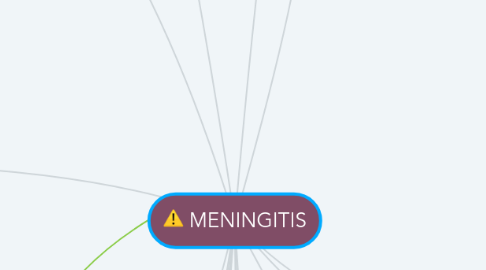
1. Nursing Diagnosis
1.1. Ineffective Tissue Perfusion (Cerebral) RT Increased intracranial pressure Possibly evidenced by Delirium, hallucinations Drowsiness Hypercapnia
1.2. Hyperthermia RT Infection OR Abnormal temperature regulation evidenced by Body temperature above the normal range Hot, flushed skin
1.3. Acute Pain RT Increased intracranial pressure evidenced by Neck stiffness orHeadache or Irritability
1.4. Disturbed Sensory Perception RT Decreased LOC or Cerebral edema evidenced by Altered sensorium
1.5. Anxiety RT change in environment [hospitalization)evidenced by Expressed concern and worry about actual hospitalization of child and seriousness of illness
1.6. Risk for Injury RT Internal factor of altered neurologic regulatory function
2. Nursing Planning
2.1. To improve cerebral tissue perfussion
2.2. To decrease TEMP
2.3. To decrease pain
2.4. To enhance sensory perception
2.5. To decrease anxiety
2.6. To decrease the risk for injury
3. inflammation of the membranes (meninges) surrounding the brain and spinal cord.
3.1. Viral
3.2. Bacterial
3.2.1. Streptococcus pneumoniae (pneumococcus)
3.2.2. Neisseria meningitidis (meningococcus)
3.2.3. Haemophilus influenzae (haemophilus)
3.3. Fungul
4. SIGN & SYMPTOMS
5. Severe headache that seems different than normal
6. Headache with nausea or vomiting
7. Seizures
8. Sensitivity to light
9. Skin rash (sometimes, such as in meningococcal meningitis)
10. Sudden high fever
11. COMPLICATIONS
11.1. Hearing loss Memory difficulty Learning disabilities Brain damage Gait problems Seizures Kidney failure Shock Death
12. Nursing Care Plan
13. Nursing Intervention
13.1. Monitor vital signs and neurological status.
13.1.1. Increasing systolic blood pressure accompanied by decreasing diastolic blood pressure is an ominous sign of increased ICP.
13.2. Observe for any signs of increased intracranial pressure.
13.2.1. Signs and symptoms that indicate an increase in ICP include headache, drowsiness, decreased alertness, vomiting, bulging fontanelle (infants).
13.3. Assess for nuchal rigidity, twitching, increased restlessness, and irritability.
13.3.1. These are signs of meningeal irritation, which may happen because of infection.
13.4. Monitor arterial blood gases (ABGs) and oxygen saturation.
13.4.1. Determines presence of hypoxia and indicates therapy needs.
13.5. Maintain head or neck in midline position, provide small pillow for support.
13.5.1. Turning head to one side compresses the jugular veins and inhibits venous drainage, thereby increasing ICP.
13.6. Provide comfort measures and Decrease external stimuli such as quiet environment, soft voice, and gentle touch.
13.6.1. Produces relaxing effect which decreases adverse physiologic response and promotes rest to maintain or lower ICP.
13.7. Elevate the head of the bed 30°, and avoid neck flexion and hip flexion.
13.7.1. Promotes venous drainage from head, thereby reducing cerebral congestion and edema and risk of increased ICP.
13.8. Assess for signs of dehydration such as dry mouth, sunken eyes, sunken fontanelle, low concentrated urine output.
13.8.1. Elevated body temperature increases the metabolic rate, hence increases the insensible fluid loss.
13.9. Gradually decrease temperature.
13.9.1. Shivering can happen from rapid reduction of temperature which can result to rebound effect and increase the temperature instead lower the temperature.
13.10. Maintain adequate fluid intake as tolerated.
13.10.1. Prevents dehydration; Avoid fluid overload because of the risk of cerebral edema.
13.11. Administer antibiotics as indicated.
13.11.1. Antibiotics are given to treat the underlying causes of inflammation and thus prevent the occurrence of seizure activity.
13.12. Administer antipyretics as indicated.
13.12.1. Antipyretics decrease fever and lessen brain oxygen demand as fever increases cerebral metabolic demand.
13.13. Assess for headache and photophobia.
13.13.1. When the meninges of the brain become infected, it can lead to inflammation that triggers severe headaches; Meningitis also causes hypersensitivity to bright lights
13.14. Assess for Kernig’s sign (pain and resistance on passive knee extension with hips fully flexed) and Brudzinski’s sign (hips flex on bending the head forward).
13.14.1. These are used to assess for any sign of meningeal irritation.
13.15. Assess ability to follow simple or complex commands.
13.15.1. Impaired cognitive function occurs with cerebral hemisphere involvement.
13.16. Evaluate presence or absence of protective reflexes: swallow, gag, blink, cough.
13.16.1. Absence of reflexes is a late sign indicative of increasing ICP.
13.17. Assess pupil size every 3 hours during the first 24 hours and consequently every 6 hours.
13.17.1. Increased intracranial pressure (ICP) will result in uneven pupil sizes, fixed dilated pupil.
13.18. Allow parents to participate in the child’s care.
13.18.1. Support better coping and decrease anxiety.
13.19. Encourage to express concerns and ask to express concerns and ask questions regarding the condition of ill child.
13.19.1. Provides an opportunity to vent feelings, secure information needed to reduce anxiety.
13.20. Teach about disease process and behaviors, physical effects and symptoms of disease.
13.20.1. Relieves anxiety of parents.
13.21. Teach parents about isolation precautions for at least 24 hours or until diagnosis is made and antibiotic therapy begins to take effect.
13.21.1. Provides opportunity to validate type of meningitis and to take measures to prevent transmission to others in contact with child.
13.22. Administer stool softeners, avoid use of restraints and prevent or reduce crying episodes.
13.22.1. Prevents Valsalva’s maneuver that will increase ICP.
14. Stiff neck
15. Confusion or difficulty concentrating
16. Sleepiness or difficulty waking
17. No appetite or thirst
18. The most common route of infection is vascular dissemination from an infection in the nasopharynx or sinuses, or one implanted as a result of wounds, skull fracture, lumbar puncture, or surgical procedure. Viral (aseptic) meningitis is caused by a variety of viral agents and usually associated with measles, mumps, herpes, or enteritis. This form of meningitis is self-limiting and treated symptomatically for 3 to 10 days
19. MEDICAL INVESTIGATION :
19.1. Lumbar puncture
19.2. Imaging
19.2.1. CT SCAN
19.2.2. X-RAYS
